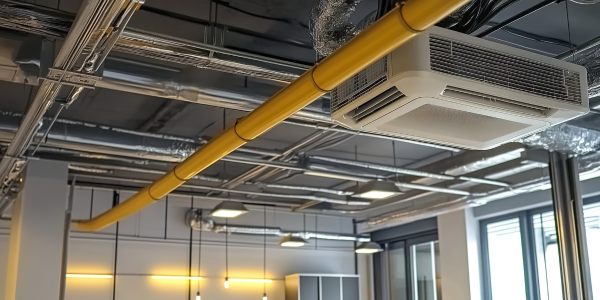Each year, Earth Day celebrates the achievements of the environmental movement and its call to arms to take further action wherever possible to protect our vulnerable climate from further deterioration. In recognition of this important day and our ongoing commitment to combating climate change, we’re outlining a few ways Building Managers, Operators and Owners can optimise their Building Management System (BMS) in order to cut down on energy consumption. Not just on Earth Day, but every day.
Six strategies to cut energy consumption
1. Automate your Building
Automated systems can more precisely control key building functions, such as heating, ventilation, air conditioning (HVAC), lighting and other energy-consuming systems based on real-time data and predefined parameters or ‘set points’. Automation ensures that energy is used only in the most efficient manner.
Owing to human error, reactive decision-making and the time and effort required to make constant adjustments, manual control of building management systems doesn’t guarantee the same degree of accuracy and therefore energy efficiency.
Another key benefit of automation includes remote access control. Building operators can keep an eye on and control energy usage from any location with an internet connection. This flexibility enables proactive management of energy usage and quick response to issues or opportunities for energy savings.
2. Set points verification
In a building management system, the set point serves as the desired target for specific energy-consuming subsystems. For example, in a HVAC system, the most common set points are used to set the desired room temperatures. Ensuring that your BMS set points are accurately configured and where feasible, adjusting them can directly influence your energy consumption rate.
For instance, during the winter season, making even a minor adjustment in your HVAC subsystem from 21 to 20oC can yield notable energy savings without significantly compromising occupants’ comfort. This subtle modification can lead to significant reductions in energy usage while maintaining a comfortable indoor environment.
It is now possible to harness the power of AI to dynamically calculate your building’s setpoints, maximising its energy-saving potential.
3. Routine maintenance
Regular maintenance of your building management system and the HVAC plant it controls is crucial for saving energy and money in the long run. By proactively addressing hardware performance issues, identifying parts nearing the end of their lifespan and performing software updates, you can extend the lifespan of your BMS while maintaining its operational efficiency.
Failure to maintain your BMS can lead to a host of problems, including excessive energy consumption, costly emergency call-outs, susceptibility to hackers, discomfort for occupants and safety hazards. Neglecting your BMS leaves it vulnerable to malfunctions and compromises its ability to regulate building conditions effectively.
As experts in BMS maintenance and installation, we’ve encountered a range of approaches to systems maintenance over the years, with each provider differing in service quality. Partnering with a BMS specialist that prioritises expertise, conducts meticulous assessments, and delivers comprehensive reports is crucial when it comes to optimising your building system.
4. Optimised scheduling
Customising the scheduling of HVAC, lighting and other building systems based on hours of use is a strategic approach to ensuring efficient energy usage. By tailoring the operation of these systems to align with actual occupancy and activity levels within the building, unnecessary energy consumption can be minimised, resulting in significant cost savings and environmental benefits.
For instance, programming your building management system to adjust HVAC settings during off-peak hours or unoccupied periods can yield substantial energy savings. Reducing heating or cooling output to maintain minimum comfort levels during periods when occupants are absent, such as evenings, weekends and holidays, can prevent energy wastage without compromising occupant comfort.
5. Further investment
Investing in additional features for your BMS can also help boost energy efficiency:
Occupancy sensors: Installing occupancy sensors in conjunction with your BMS enables agile control of lighting, HVAC and other systems based on real-time occupancy data. By automatically adjusting system settings in response to occupancy changes, energy waste in unoccupied areas or zones can be minimised.
Weather forecast integration: Incorporating weather forecast data into your BMS allows for predictive control of HVAC systems in particular. By preemptively adjusting heating or cooling settings based on anticipated weather conditions, buildings can optimise energy usage while maintaining comfort levels.
Demand response: By programming your building management system to dynamically adapt its energy consumption in reaction to demand response events, such as pricing incentives or peak demand periods on the grid, you can seamlessly reduce energy usage while also contributing to the stability of the electricity infrastructure.
6. System Analytics
Investment in automated data analytics and now AI (Artificial Intelligence) can significantly contribute to energy savings in building management systems. By collecting and analysing data from various sensors, meters and the building management systems themselves, the building operator can identify patterns, trends and opportunities for energy optimisation. This data-driven approach enables more informed decision-making and targeted energy-saving strategies. Data harvesting can also anticipate equipment failures or inefficiencies before they occur, preventing downtime and optimising energy usage. By addressing issues promptly, energy waste due to poor control or equipment malfunction can be minimised.
Long term benefits for all
While the strategies mentioned above may initially seem costly and time-intensive, they offer substantial benefits in the long term. Regular maintenance mitigates the risk of emergency repairs, safeguarding against unexpected expenses and operational disruptions. Consulting with a BMS expert streamlines the management and optimisation of the system, saving valuable time for building operators and ensuring optimal performance.
Implementing these straightforward tactics yields long-term advantages for all stakeholders. By reducing energy consumption, buildings can achieve significant cost savings without compromising occupant comfort or the longevity of the building as an asset. Moreover, these efforts play a vital role in the global fight against climate change, contributing to sustainability efforts and environmental conservation.
Cube Controls is an established and experienced supplier of Building Management Systems, specialising in the design and set-up of bespoke environmental and energy control programmes for commercial buildings and property.




